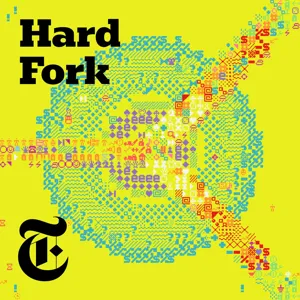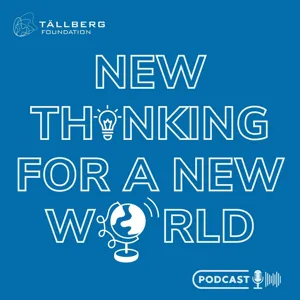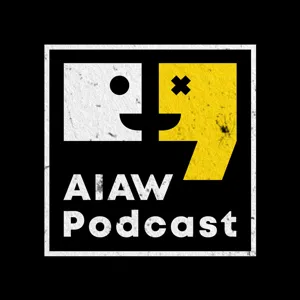Podcast Summary
Dentist Visit Due to Accidentally Broken Tooth on Candy 'Dots': Casey visited the dentist due to a broken tooth from eating 'Dots' candy during Halloween, expressing disappointment and frustration, and suggesting a ban.
The speaker, Casey, had to visit the dentist after accidentally breaking a tooth on a candy called "dots," which he believes should be regulated due to its hard and sticky texture. The incident occurred during Halloween, and Casey expressed his disappointment and surprise as the candy was the only one in stock at the store. He also shared his frustration about the annual panic surrounding Halloween candy safety and called on the Biden administration to consider banning dots. Meanwhile, Kevin Ruse, the tech columnist for The New York Times, shared his exciting experience of visiting the White House to discuss the new president's executive order on artificial intelligence.
White House Orders Regulation of Next-Gen AI Models: The White House issued an executive order mandating disclosures and safety tests for next-gen AI models, signaling increased government oversight and involvement in the industry.
That the White House recently put into place an executive order aimed at regulating artificial intelligence (AI), particularly the creation of next-generation models. This order, which includes industry leaders and government officials, requires companies to inform the federal government when they train such models and disclose safety tests. The industry was caught off guard by this, as the threshold for these requirements is a significant amount of computing power. The order also addresses potential harms of AI, such as discrimination, bias, fraud, and disinformation, and requires government agencies to prevent AI from encouraging these issues. Overall, this executive order signals to the AI industry that Washington is paying close attention and will be involved from the early stages.
The Debate over Reporting Large AI Models to the Government: Open source AI advocates argue for safer, democratized tech and transparency, while closed approach supporters prioritize rigorous testing and safety measures. The controversy centers around a government order requiring reporting of large AI models for safety testing, which some fear could be a regulatory capture barrier for smaller competitors.
The ongoing debate in the tech industry revolves around the controversial executive order regarding reporting large AI models to the government. The order has sparked controversy due to the potential implications for open source AI versus a more closed approach. Open source proponents argue that it leads to safer, better tech, democratization, and transparency. On the other hand, closed approach advocates prioritize rigorous testing and safety measures, fearing potential harm. The controversy intensified with the requirement to report if training a model larger than a certain size, which some view as a potential step towards regulatory capture and a barrier for smaller competitors. However, it's important to note that the order doesn't restrict the development or open source nature of large models, but rather requires reporting for safety testing and potential hazards.
The Debate on AI Regulation: Closed vs Open Access: Industry leaders call for AI regulation due to safety concerns, but some view it as a cynical move. The government's involvement is inevitable due to AI's widespread applications and potential risks.
The debate surrounding AI regulation is intensifying, with some advocating for a closed approach to prevent potential risks, while others argue for open access to foster innovation. The concern over AI safety is not new, with industry leaders like Dario Amodeo and Sam Altman expressing their worries for years. The recent push for regulation, however, has raised questions about the true intentions behind these calls. Some argue that it's a cynical move to enrich themselves, while others believe it's a necessary step to ensure safety. The government's involvement was inevitable due to AI's widespread applications and potential impact. During a visit to the White House, the interviewee discussed the open source issue with Arthur Prabhakar, who heads the Office of Science and Technology Policy. Prabhakar acknowledged the dual nature of AI, with it democratizing technology and proliferating potential risks. The debate will continue, and the path forward will involve ongoing discussions and learning from various perspectives.
Balanced Approach to AI Regulation: The Biden White House aims to address potential harms and benefits of AI through a balanced regulatory approach, recognizing both positive use cases and potential risks.
The Biden White House is approaching AI regulation with a balanced perspective, acknowledging both the potential harms and benefits. While there is optimism about the upsides, such as microclimate forecasting and renewable energy development, there is also recognition of the potential risks, like bio-weapons and cybersecurity. This approach is a pleasant surprise compared to some proposed regulations that overlook positive use cases, like the proposed elimination of Section 230 of the Communications Decency Act. However, it remains to be seen how effective this executive order will be in practice, and whether it goes far enough to address existential threats from AI. The speaker's view on AI has not necessarily changed, but their perspective on the regulatory response may have shifted, recognizing the need for balance and the potential for AI to bring about positive change.
Addressing potential risks of advanced AI technologies: Governments should proactively address potential harms and risks of advanced AI technologies by identifying risks and developing mitigations now.
While it's challenging to predict the exact future implications of advanced AI technologies, it's crucial for governments to begin addressing potential harms and risks proactively. Regulation against theoretical future harms is difficult, and history shows that significant regulations often arise in response to catastrophic events. However, the recent executive order in the US is a step in the right direction, focusing on developing content authenticity standards and addressing potential bioweapon risks. Europe, which is more advanced in AI regulation, might set the standard for the rest of the world. The key is to start identifying potential risks and developing mitigations now, before the situation becomes more serious.
Artists Sue Stability AI Over Copyright Infringement: A recent ruling allows a copyright infringement claim against Stability AI to proceed, while most claims against Midjourney and DeviantArt were dismissed due to unregistered copyrights. The case highlights the need for clear guidelines and regulations in the rapidly evolving field of AI and intellectual property rights.
The legal battle between artists and AI companies over copyright infringement continues, with a recent ruling allowing a claim against Stability AI to move forward. The case, brought by a group of artists including cartoonist Sarah Anderson, alleges that Stability AI's stable diffusion image generator directly infringed on their copyrighted works. However, most of the claims against other companies, Midjourney and DeviantArt, were dismissed due to unregistered copyrights. This ruling marks a significant development in the ongoing debate over who owns the rights to creative works used to train AI models. The core issue of whether artists have been wronged in a way that can result in financial compensation remains to be resolved. The legal battle underscores the need for clear guidelines and regulations in the rapidly evolving field of AI and intellectual property rights.
AI-generated content and copyright: Established copyright principles apply to AI-generated content, but human involvement and authorship are contentious issues. Simple outputs might not be eligible for copyright, while complex outputs could be considered human-authored.
The legal status of AI-generated content, particularly in the realm of copyright, is a complex and evolving issue. According to Rebecca Tushnet, a copyright law expert and professor at Harvard Law School, the established copyright principles can be applied to AI-generated content, but there are nuances and debates surrounding human involvement and authorship. For instance, simple outputs like a banana image generated by an AI might not be eligible for copyright protection due to the lack of human authorship. However, more complex prompts that result in distinct outputs, such as a banana dressed as a 1940s detective, might be considered more human-authored and thus eligible for copyright. The question of whether to count the prompt as human authorship is a contentious one, with some arguing that it should be enough to secure copyright. Another issue is what happens to the rejected outputs. These debates underscore the need for ongoing discussions and potential legal changes to address the unique challenges posed by AI-generated content in the copyright landscape.
Copyright implications of AI models on copyrighted material: The legal landscape around AI models using copyrighted material is evolving, with some arguing it's a violation and others fair use. Google Books Project serves as an analogy, but the output of AI models may look like copyrighted works without compensation. The responsibility for preventing unauthorized use lies with creators and platforms.
The copyright implications of training AI models on copyrighted material is a complex issue, with some arguing that it's a violation of copyright, while others believe it falls under fair use. The Google Books Project serves as an analogy, where Google makes copies of existing works to create an index, but doesn't reproduce them exactly. However, the output of AI models, such as stable diffusion, may look like copyrighted works without the original creator receiving any compensation. The question of whether these models truly transform the input or simply collage it remains a point of contention. The legal landscape is still evolving, and it will be important to monitor how courts handle these cases. Ultimately, the responsibility for preventing unauthorized use of copyrighted material rests with the creators and the platforms, and it's crucial to continue the conversation around safe design and fair use in the age of AI.
Use of artists' work in AI training and copyright law: The use of artists' work in AI training can be a complex copyright issue, with outcomes uncertain and expensive to litigate. Fair use may apply, but licensing everything is not required.
The use of artists' work as training data for AI models can be a complex issue when it comes to copyright law. While some argue that this use falls under fair use, artists can still pursue copyright claims based on direct infringement. However, the outcome of these cases is uncertain and expensive to litigate. The law has historically not required companies to license all data used in their models, even if they choose to do so. Fair use can be a costly legal battle, but it doesn't necessarily mean that licensing everything is the only solution. The debate around the use of copyrighted material in AI training continues, and it's essential for companies and artists to stay informed about the latest developments in this area.
Actions for artists to protect their work in AI era: Artists can consider opt-outs, ethical considerations, and moral arguments to protect their work in AI era. Traditional licensing deals may not be feasible, and compensation models have limitations. Size and scope of AI models impact their protection from lawsuits.
While there are ongoing debates about the use of AI systems in creating art and the legal protections for artists, there are some actions artists and creators can take. Voluntary opt-outs, similar to Google's respect for robot exclusion headers, can limit the use of one's work without legal requirements. However, the effectiveness and fairness of these opt-outs are subject to debate. Regarding compensation, traditional licensing deals may not be feasible for individual artists due to the high costs involved. Instead, ethical considerations and moral arguments may play a more significant role in the future of protecting artists' rights. However, skepticism exists regarding the effectiveness of models that compensate artists, as the majority of the revenue may not reach the artists themselves. The size and scope of AI models can also impact their protection from potential lawsuits, as larger models with more data may be less susceptible to infringement claims. The ongoing Westlaw case highlights the limitations of licensing deals for individual creators, as the people who wrote the summaries at Westlaw do not see any additional compensation even if the company prevails in the lawsuit. Ultimately, the use of AI in creating art raises complex legal and ethical questions, and while there are no clear-cut answers, creators and artists can take actions to protect their work and advocate for their rights.
Discussing AI liability and copyright protections: AI companies argue they're just tools, but users are responsible for infringing material. Copyright protections may not effectively address new technologies, and economic structures need reconsideration for artist compensation.
While AI companies argue they are just providing tools and not responsible for how users utilize them, the liability for creating and distributing infringing material, such as counterfeit money or porn, ultimately falls on the user. The conversation also touched on the idea that artists and writers have long relied on copyright protections, but the rise of new technologies may not be effectively addressed by handing out more rights without considering broader economic structures and how artists are compensated. The conversation ended with a light-hearted segment discussing Halloween candies and a game called Hat GPT.
Exploring the unpredictable world of AI and technology: From Hat GPT to AI-generated Seinfeld, technology's evolution and AI's capabilities continue to surprise us, raising important questions about their implications.
Technology and AI are continuously evolving, with new developments and applications emerging frequently. This was highlighted in a discussion about Hat GPT, a game where news stories about technology are drawn from a hat and AI generates plausible language about them until one person gets tired. The group also talked about an AI-generated Seinfeld live stream that had been running for months, with one character endlessly walking into a refrigerator. They found it intriguing that the show, which was famously about nothing, had evolved into almost nothing and yet was more popular than ever. Another topic was a barge-based compute cluster called the Blue Sea Frontier, which was being used as a way to avoid government regulations on AI reporting. The group also discussed Joe Biden's growing concerns about AI after seeing AI-generated images and learning about voice cloning technology. Overall, the discussion underscored the importance of staying informed about the latest tech trends and the potential implications of AI.
AI in news: Oversight needed to prevent insensitive results: Microsoft news aggregator generated insensitive poll, highlighting need for ethical AI use in news
The use of AI in generating news content, including polls, requires careful oversight to prevent inappropriate or insensitive results. This was highlighted in a recent incident where a Microsoft news aggregator generated an insensitive poll regarding the death of a young woman, which was published next to an article about her on The Guardian. The president's reaction to a fictional AI entity in the movie "Mission Impossible" also serves as a reminder of the potential impact of media portrayals of AI on public perception and policy-making. While the potential benefits of AI in news aggregation and content generation are significant, it is crucial to ensure that the technology is used responsibly and ethically to avoid causing harm or offense.
The role of humans in AI and technology: While AI and technology offer innovative solutions, human decisions and actions play a crucial role in their implementation and impact. Human oversight and accountability are essential in the age of AI and technology.
While AI and technology can offer innovative solutions, ultimately, human decisions and actions play a crucial role in their implementation and impact. The Microsoft example of using AI-generated polls in news articles highlights this, as it was a human decision to implement these polls, not an AI one. In the case of Cruise's driverless cars, a human error led to a controversial incident, resulting in regulatory action and the pause of operations. Regulators are enforcing stricter scrutiny on self-driving cars, and this incident may be a significant setback for their widespread adoption. Additionally, Waymo's new addition of barf bags in their rides could be a response to potential passenger behavior or a precautionary measure. These examples underscore the importance of human oversight and accountability in the age of AI and technology.
Unexpected twists and turns in everyday experiences: Be adaptable and prepared for the unexpected in all situations, even the seemingly mundane.
Even in seemingly mundane situations, unexpected twists and turns can occur. During the discussion, the speaker expressed confusion about a smooth ride, unsure if they should expect turbulence or not. This highlights the importance of being adaptable and prepared for the unexpected. Additionally, the team discussed the acquisition of a hat for the show, with a budget set aside for it. The speaker joked about not wearing hats due to his spiky hair, but ultimately agreed to wear one for the show. The conversation also included various production team members and their roles in creating the podcast. Overall, this exchange showcases the unexpected nature of everyday experiences and the importance of being flexible and prepared.










